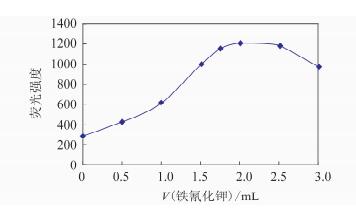Determination of Lead in Tea Garden Soil by Hydride Generation Atomic Fluorescence Spectrometry with Microwave Digestion
-
摘要: 样品用王水微波消解浸提,氢化物发生-原子荧光光谱法测定茶园土壤中痕量铅的含量。对样品浸取方法、实验条件、增感剂和共存元素进行了条件实验。结果表明,王水微波消解浸取,铅浸出量最大,减少了试剂用量和环境污染;铁氰化钾-盐酸羟胺体系有显著的增感作用,铁氰化钾在配制溶液时用米糠除去试剂中可能存在的铅,降低了空白;钴、锌、砷、镉等共存离子不干扰铅的测定,通过加入邻菲啰啉-硫氰酸钠消除铁和铜的干扰,提高了铅的回收率。方法检出限为0.65 μg/L,精密度(RSD,n=10)为1.89%,回收率在86.8%~110.4%之间。用土壤标准物质验证,测定值与标准值相符,方法快速准确,适合于大批量样品的分析检测。
-
关键词:
- 茶园土壤 /
- 铅 /
- 微波消解 /
- 氢化物发生-原子荧光光谱法
Abstract: The microwave digestion system with aqua regia was developed for the determination of trace lead in tea garden soil using Hydride Generation-Atomic Fluorescence Spectrometry (HG-AFS). The leaching methods, experimental conditions, booster and coexisting element were optimized. The largest amount of lead was leached out by microwave digestion with aqua regia, which has the advantages of less usage of reagent and less environmental pollution. An appropriate amount of potassium ferricyanide and hydroxylamine hydrochloride improved the hydride generation efficiency of Pb. The lead blank was reduced significantly when Potassium ferricyanide solution was treated with rice husk to remove Pb in the reagent. It was found that Co, Zn, As, and Cd did not interfere with the determination of lead. The addition of 1,10-phenanthroline monohydrate and sodium hydrosulfide could effectively eliminate the interferences from Fe and Cu, which improved the recovery rate of lead. The limit of detection was 0.65 μg/L and the precision was 1.89% (n=10) with recoveries of 86.8%-110.4% for Pb. The reliability of the method has been tested by determination of Pb in the Soils Standard Reference Materials and the results are in agreement with the certified values. The method has been applied to the determination of Pb in tea garden soil with satisfactory results. It was also particularly suitable for large batches of samples. -

-
表 1 不同消解体系对铅测定的影响
Table 1. Analytical results of Pb with different digestion conditions
标准物质编号 标准值w(Pb)/(μg·g-1) 测定值w(Pb)/(μg·g-1) 加标量w(Pb)/(μg·g-1) 回收率/% 方法1 方法2 方法3 方法1 方法2 方法3 方法1 方法2 方法3 GBW 07401 98±6 96 80 93 50 50 50 95.2 80.1 93.1 GBW 07402 20±3 20 15 18 15 15 15 93.1 78.1 89.8 表 2 共存元素的影响及消除
Table 2. The influence and elimination of interference elements
共存元素 共存量ρB/(mg·L-1) 铅的回收率/% 无抑制剂 有抑制剂 Fe 50 80.2 101.5 Co 10 93.1 89.5 Cu 10 75.3 95.1 Zn 10 90.1 92.1 As 10 90.5 93.5 Cd 10 88.3 89.5 表 3 实际样品分析结果
Table 3. Analytical results of Pb in real samples
样品编号 w(Pb)/(μg·g-1) 回收率/% 试样铅含量 铅标准加入量 测得总铅量 T091001 100.1 50 143.5 86.8 T091002 80.2 50 128.9 97.4 T091003 50.9 50 96.0 90.2 T091004 60.2 50 113.1 105.8 T091005 35.3 50 90.5 110.4 -
[1] 陈宗懋, 吴洵.关于茶叶中的铅含量问题 [J].中国茶叶, 2000, 22(5): 3-5. http://www.cnki.com.cn/Article/CJFDTOTAL-CAYA200005000.htm
[2] 徐金瑞, 庄秀润.邻氨基苯甲酸电化学修饰电极及其铅的测定[J].环境科学, 1991, 12(1): 59-62. http://www.cnki.com.cn/Article/CJFDTOTAL-HJKZ199101013.htm
[3] 区红, 何华焜.氢化物发生/原子吸收分光光度法测定食盐中铅 [J].分析试验室, 2002, 21(4): 96-98. http://www.cnki.com.cn/Article/CJFDTOTAL-FXSY200204031.htm
[4] 梁宇宁, 黄智, 何星存, 陈孟林.氢化物原子吸收法测定高纯度碳酸钙中铅 [J].分析试验室, 2007, 26(Z1): 21-22. doi: 10.3969/j.issn.1000-0720.2007.z1.007
[5] GB/T 17140—1997, 土壤质量铅、镉的测定;KI-MIBK萃取火焰原子吸收分光光度法[S].
[6] 欧阳玉祝, 吴道宏, 舒庆敏, 李勇, 陈功锡.火焰原子吸收分光光度法测定路边青中重金属含量[J].分析科学学报, 2011, 27(4): 516-518. http://www.cnki.com.cn/Article/CJFDTOTAL-FXKX201104029.htm
[7] GB/T 17140—1997, 土壤质量铅、镉的测定;石墨炉原子吸收分光光度法[S].
[8] 张卫锋, 洪振涛, 邓香连, 刘颖琪.微波消解、石墨炉原子吸收光谱法测定土壤中的铅[J].光谱实验室, 2005, 22(6): 1204-1206. http://www.cnki.com.cn/Article/CJFDTOTAL-LDYX201208010.htm
[9] 李达, 杭义萍, 吴彩云.微波消解-氢化物发生-原子荧光光谱法测定出口芳香油中痕量铅[J].分析科学学报, 2009, 25(6): 738-740. http://www.cnki.com.cn/Article/CJFDTOTAL-FXKX200906032.htm
[10] 杨敬金, 张加玲.浊点萃取-氢化物发生-原子荧光光谱法测定水样中痕量铅[J].理化检验: 化学分册, 2011, 47(3): 275-277. http://www.cnki.com.cn/Article/CJFDTOTAL-LHJH201103010.htm
[11] 蒋倩, 韩勇, 华建峰, 钱薇, 陆国兴.氢化物发生-原子荧光光谱法测定大米与圆白菜中痕量铅[J].光谱实验室, 2012, 29(2): 658-662. http://www.cnki.com.cn/Article/CJFDTOTAL-GPSS201202003.htm
[12] 高舸, 陶锐.氢化物发生-原子荧光光谱法测定铅的研究进展[J].中国卫生检验杂志, 2005, 15(4): 509-512. http://www.cnki.com.cn/Article/CJFDTOTAL-ZWJZ200504021.htm
[13] 彭俊, 杨淞, 朱光辉, 杨蕾, 叶红利.氢化物-原子荧光光谱法检测生活饮用水中的痕量铅[J].光谱实验室, 2011, 28(3): 1388-1392. http://www.cnki.com.cn/Article/CJFDTOTAL-GPSS201103099.htm
[14] 高舸, 陶锐.氢化物发生-原子荧光光谱法测定铅的研究 (Ⅰ) 铁氰化钾试剂的影响[J].中国卫生检验杂志, 2004, 14(3): 282-284.
[15] 李锋格, 全晓盾, 李世雨, 王成.氢化物原子荧光法测定食品中痕量铅[J].理化检验: 化学分册, 2006, 42(4): 260-264. http://www.cnki.com.cn/Article/CJFDTOTAL-LHJH200604008.htm
[16] 李海峰, 王庆仁, 朱永官.土壤重金属测定两种前处理方法比较的研究[J].环境化学, 2006, 25(1): 108-109. http://www.cnki.com.cn/Article/CJFDTOTAL-ZYJH201707049.htm
[17] 胡珊珊, 钱秀芳.微波消解技术在土壤重金属元素测定中的应用[J].安徽师范大学学报: 自然科学版, 2010, 33(4): 363-366. http://www.cnki.com.cn/Article/CJFDTOTAL-AHSZ201004012.htm
[18] Sin S N, Chua W, Lo W, Ng L M.Assessment of heavy metal cations in sediments of Shing Mun River, Hong Kong [J].Environmental Geochemistry in the Tropics and Subtropics,2001,26(5-6): 297-301.
[19] Wong K K, Lee C K, Low K S, Haron M J. Removal of Cu and Pb from electroplating wastewater using tartaric acid modified rice husk [J].Process Biochemistry,2003,39(4): 437-445. doi: 10.1016/S0032-9592(03)00094-3
[20] Castillo J R, Mir J M, Val J. Study of interference in the determination of lead by hydride generation-direct flame atomic absorption spectrometry when oxidizing agents employed to increase the sensitivity [J].Analyst,1985,110(10): 1219-1221. doi: 10.1039/AN9851001219
[21] GB 15618—1995, 土壤环境质量标准[S].
-




 下载:
下载:
